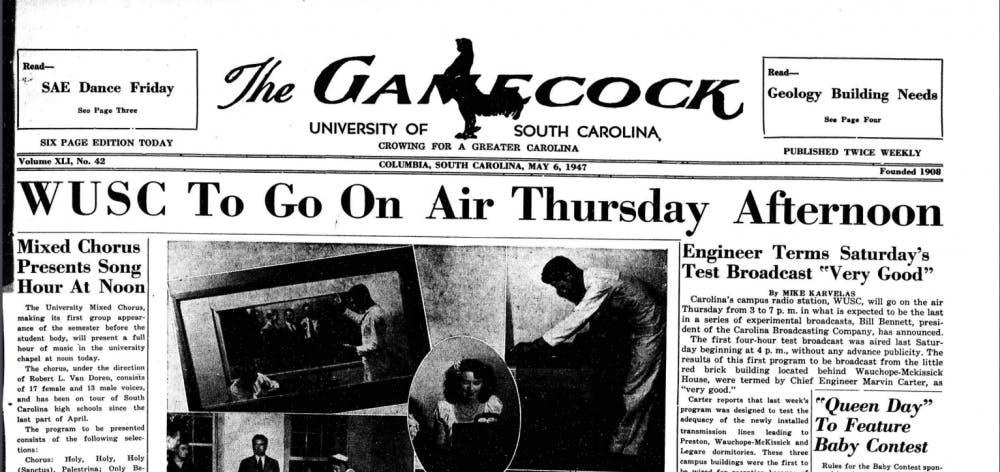There are definitely stereotypes of college radio and the college radio DJ. If you set foot into WUSC, you’d realize that those stereotypes exist for a reason. There isn’t a single place on campus like WUSC. This year marks the 70th year of WUSC-FM, the University of South Carolina’s radio station. Maybe you know a DJ, know someone who knows a DJ or have accidentally stumbled onto it in your car radio. Or maybe this is the first time you have been made aware that USC has a radio station.
Much like The Daily Gamecock, WUSC has been a creative outlet for students. If you look at a program schedule for WUSC, you’ll find any and every type of music being played. That’s the main reason why people join WUSC. That’s why I joined WUSC, for the music. A lot of students that join other student media outlets to build a professional portfolio. Sure, some do it as a hobby, but many want to pursue a career in media. Student Media at USC is a great springboard into the professional world.
At WUSC, there are a handful of students who want to work in radio or broadcast after college. But to the vast majority of DJs, WUSC is their place where they have absolute creative freedom to broadcast whatever they want — to an extent. Why is college radio appealing, you might ask? I’ll try and provide an example: Have you ever wanted the aux cord in the car to show off some music, or send a friend back home a song you just heard? College radio gives someone the chance to do that for two hours every week. Two hours to show people all around the world (yes, we stream at wusc.sc.edu) music that they might like.
This isn’t just the culture of WUSC. The idea of showcasing the newest music is representative of the majority of college radio stations across the country. From KUSC in Southern Cal to WUSC, college radio has always been at the forefront of the curve in discovering the newest music. Hootie and the Blowfish broke into the Columbia airwaves on WUSC. R.E.M. broke out on UGA’s radio station WUOG. Kanye West made his radio debut at WHPK at the University of Chicago. There are many reasons as to why so many artists break on college radio stations, but the main reason is due to the nature of college radio’s existence.
NPR affiliates and the majority of college radio stations exist on the low end of the FM dial from 88.1 to 91.9. This 20 frequency range was reserved by the FCC in the 1940s so noncommercial educational stations would be able to grow without fear of being consumed by commercial radio. Every couple of years, stations have to reapply for a license to broadcast. For these college radio stations to maintain their license, they have to demonstrate their service as a resource for the community they broadcast in. When college radio stations started reapplying for their FM NCE licenses, stations started adjusting their programming to be different than commercial stations. The biggest and most educational aspect of programming to change was music. Interestingly enough, our station motto is to educate the DJ and the listener.
College radio began playing what would be on commercial stations six months to a year in advance. The adjustment of programming coupled with the college mindset to “discover” caused an inundation of new music to hit airwaves across the country. This ushered in the creation of College Music Journal. CMJ was a trade magazine for college radio that would publish playlists and music charts from popular college radio stations. WUSC was a dedicated contributor. In 1983, Rolling Stone Magazine named WUSC a “taste maker” in music. College radio remained the premier outlet for listening to the newest music. But near the turn of the century, college radio started to lose its ground.
The advent of streaming services and internet radio forced college radio to rebrand itself. Much like how the internet forced many newspaper publications to focus on their online presence, the internet forced college radio to reinvent its programming. Unfortunately, it’s been difficult for college radio to get back to the the level of relevance it once had in the '80s and '90s. In the mid 2000s, more and more colleges started selling their NCE licenses. Recent notable examples are KTRU at Rice and WRVU at Vanderbilt selling their terrestrial broadcast license. College radio went more underground and still pushes the boundaries of what type of music is getting airtime. If you tune into WUSC right now, I’d bet the farm they’re playing something you’ve never heard before.
Will college radio ever get back to its prominence it had in the '80s and '90s? It’s hard to say. But there still is a place for college radio on the dial. There’s a connection that college radio creates. A connection of broadcasters and listeners coming together. Whether it’s new music, or just another voice in the car WUSC has been there. It has been for over 70 years, and shows no signs of slowing down.
*Parts 1 and 2 of the 6-part history of WUSC will air this Friday at 12 p.m. on WUSC.

